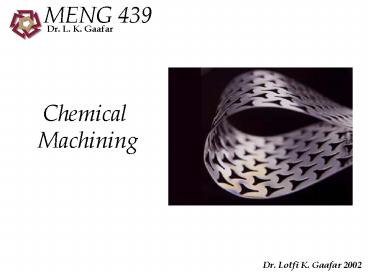Chemical Machining PowerPoint PPT Presentation
1 / 11
Title: Chemical Machining
1
MENG 439
Dr. L. K. Gaafar
Chemical Machining
2
Chemical Machining
- Was developed based on the observation that
chemicals attack metals and etch them by using
chemical dissolutions. - Is the oldest of nontraditional machining
processes, and has been used to engrave metals
and hard stones.
- Can be classified into
- Chemical Milling
- Chemical Blanking
3
Chemical Milling
- Shallow cavities on sheets, plates, etc
- Selective attack by chemicals on workpiece
- Used in aerospace industry
- Used to fabricate microelectronic devices
4
Chemical Blanking
- Blanking of sheet metals
- Material removed by chemical dissolution
- Used to produce fine screens, flat springs, etc
- Very cheap but efficient
5
Characteristics of Chemical Machining
- Shallow removal of material(up to 12mm)
- Blanking of thin sheets
- Low tooling equipment cost
- Suitable for low production runs
- Material removal rate(0.1mm/min)
6
Photo Chemical Machining (PCM)
- PCM is a material removal process using chemicals
(etchants) to produce high precision parts. - This process is also known as Photo Etching,
Chemical Blanking and Photo Chemical Milling.
7
PCM Process
- Artwork- generate design using CAD systems, then
plot it using a high precision laser plotter to
produce photo-tool. - Chemically clean the metal surface.
- Coat both sides of the plate with photoresist.
(photoresist is a polymer that adheres to the
metal when exposed to UV light).
http//web.mit.edu/ndemarco/www/chemmilling/slide6
.html
8
PCM Process Cont.
- Expose plate and photo-tool to ensure image
transfer. - Spray metal with etchant or dip it in hot acidic
solution to etch all material other than part
covered with photoresist (1-15 min.). - Rinse the plate to ensure photoresist and etchant
removal.
http//web.mit.edu/ndemarco/www/chemmilling/slide6
.html
9
Advantages
- Low Tooling Cost- all tooling is produced by CAD
systems at a low cost with a short creation time. - Low Modification Cost- short runs are possible at
a low cost, thus, design can be easily modified. - Burr and Stress Free.
- Complex Designs.
- Thin Plates as thin as 0.005.
10
Materials
- Aluminum
- Chromium
- Copper (oxygen free, rolled)
- Nickel
- Steel (carbon, stainless)
- Lead
- Zinc
11
Applications
- High Precision Parts
- and Decorative Items
- Gaskets
- Washers
- Sensors
- Nameplates
- Jewelry
- Microprocessor Chips
http// www.suron.com

